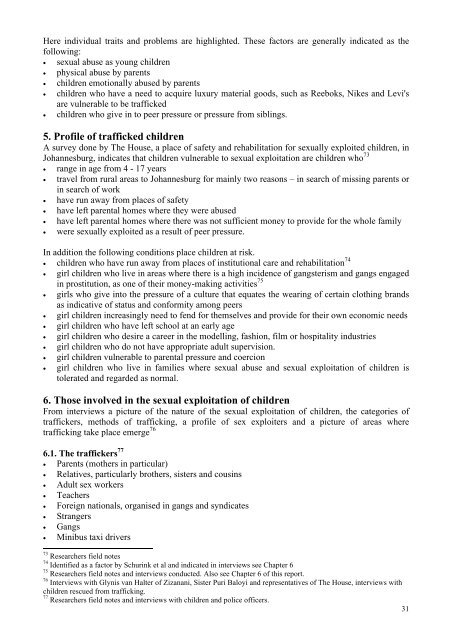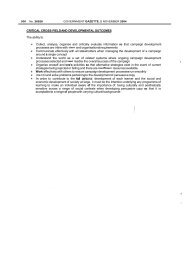The trafficking of children for purposes of sexual exploitation
The trafficking of children for purposes of sexual exploitation
The trafficking of children for purposes of sexual exploitation
You also want an ePaper? Increase the reach of your titles
YUMPU automatically turns print PDFs into web optimized ePapers that Google loves.
Here individual traits and problems are highlighted. <strong>The</strong>se factors are generally indicated as the<br />
following:<br />
• <strong>sexual</strong> abuse as young <strong>children</strong><br />
• physical abuse by parents<br />
• <strong>children</strong> emotionally abused by parents<br />
• <strong>children</strong> who have a need to acquire luxury material goods, such as Reeboks, Nikes and Levi's<br />
are vulnerable to be trafficked<br />
• <strong>children</strong> who give in to peer pressure or pressure from siblings.<br />
5. Pr<strong>of</strong>ile <strong>of</strong> trafficked <strong>children</strong><br />
A survey done by <strong>The</strong> House, a place <strong>of</strong> safety and rehabilitation <strong>for</strong> <strong>sexual</strong>ly exploited <strong>children</strong>, in<br />
Johannesburg, indicates that <strong>children</strong> vulnerable to <strong>sexual</strong> <strong>exploitation</strong> are <strong>children</strong> who 73<br />
• range in age from 4 - 17 years<br />
• travel from rural areas to Johannesburg <strong>for</strong> mainly two reasons – in search <strong>of</strong> missing parents or<br />
in search <strong>of</strong> work<br />
• have run away from places <strong>of</strong> safety<br />
• have left parental homes where they were abused<br />
• have left parental homes where there was not sufficient money to provide <strong>for</strong> the whole family<br />
• were <strong>sexual</strong>ly exploited as a result <strong>of</strong> peer pressure.<br />
In addition the following conditions place <strong>children</strong> at risk.<br />
• <strong>children</strong> who have run away from places <strong>of</strong> institutional care and rehabilitation 74<br />
• girl <strong>children</strong> who live in areas where there is a high incidence <strong>of</strong> gangsterism and gangs engaged<br />
in prostitution, as one <strong>of</strong> their money-making activities 75<br />
• girls who give into the pressure <strong>of</strong> a culture that equates the wearing <strong>of</strong> certain clothing brands<br />
as indicative <strong>of</strong> status and con<strong>for</strong>mity among peers<br />
• girl <strong>children</strong> increasingly need to fend <strong>for</strong> themselves and provide <strong>for</strong> their own economic needs<br />
• girl <strong>children</strong> who have left school at an early age<br />
• girl <strong>children</strong> who desire a career in the modelling, fashion, film or hospitality industries<br />
• girl <strong>children</strong> who do not have appropriate adult supervision.<br />
• girl <strong>children</strong> vulnerable to parental pressure and coercion<br />
• girl <strong>children</strong> who live in families where <strong>sexual</strong> abuse and <strong>sexual</strong> <strong>exploitation</strong> <strong>of</strong> <strong>children</strong> is<br />
tolerated and regarded as normal.<br />
6. Those involved in the <strong>sexual</strong> <strong>exploitation</strong> <strong>of</strong> <strong>children</strong><br />
From interviews a picture <strong>of</strong> the nature <strong>of</strong> the <strong>sexual</strong> <strong>exploitation</strong> <strong>of</strong> <strong>children</strong>, the categories <strong>of</strong><br />
traffickers, methods <strong>of</strong> <strong>trafficking</strong>, a pr<strong>of</strong>ile <strong>of</strong> sex exploiters and a picture <strong>of</strong> areas where<br />
<strong>trafficking</strong> take place emerge 76<br />
6.1. <strong>The</strong> traffickers 77<br />
• Parents (mothers in particular)<br />
• Relatives, particularly brothers, sisters and cousins<br />
• Adult sex workers<br />
• Teachers<br />
• Foreign nationals, organised in gangs and syndicates<br />
• Strangers<br />
• Gangs<br />
• Minibus taxi drivers<br />
73 Researchers field notes<br />
74 Identified as a factor by Schurink et al and indicated in interviews see Chapter 6<br />
75 Researchers field notes and interviews conducted. Also see Chapter 6 <strong>of</strong> this report.<br />
76 Interviews with Glynis van Halter <strong>of</strong> Zizanani, Sister Puri Baloyi and representatives <strong>of</strong> <strong>The</strong> House, interviews with<br />
<strong>children</strong> rescued from <strong>trafficking</strong>.<br />
77 Researchers field notes and interviews with <strong>children</strong> and police <strong>of</strong>ficers.<br />
31
















